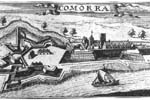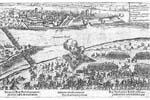|
Because of the
trading and military importance of river
crossings, they have played a strategically
significant role for thousands of years.
Komarno’s earlier settlements controlled the
waterways of the Danube, Vaag and Nitra
rivers. Not only did they control the
rivers, but also the roads that went through
the Nitra River valley. This placed the
occupants of this junction in a key
position.
Owning this
important international trade
intersection (being no other crossing
nearby) meant one had power over the
region.
It is
likely, though not proved, that the
Romans, who usually secured all the
river crossings and confluences, built
the first fortress within the Limes
Romanus in the location of the present
Old Fortress. The area of the present
town situated on the right bank of the
river Danube belonged to the region of
Brigetio (Szőny), which was situated
slightly to the east.

|
After the
defeat of the German kvad people, the
Roman Emperor Marcus Aurelius also
ordered fortresses built on the left
side of the river in 171. One of these
fortresses can be found 4 km from
Komarno, in the region of Izsa. (Celemantia
– Leányvár). The encampment, which was
surrounded by earthen ramparts, was
built under the reign of Domitianus.
These ramparts were later strengthened
with stone walls by the soldiers of the
first Roman legion. Some centuries later
the stone walls of the encampment were
demolished, and a significant part of
the material was used for the building
of the so called “Old Fortress” in
Komarno. It has not been proved yet
whether a similar Roman fortress existed
in the territory of the present Old
Fortress. Anonymus (1173-1196) was the
first who reported the location of the
fortress in Komarno, the inhabited parts
of the area and the possibilities of
natural defence. In his book, Gesta
Hungarorum, Anonymus says the following
about the foundation of the town:
”But Ketel
received not only this part but a lot
more, as after invading Pannonia Arpad
gave him a large area where the Vaag
flows into the river Danube in exchange
for his loyalty. Here, later the son of
Ketel, Alaptolma, built a castle, which
he called Komárom.
He sent
two-thirds of the people he brought with
him and two thirds of the people he won
from the leader to serve in the
stronghold of Komarno. After many years
Ketel and his son Tolma were both buried
in this place.”

|
Komarno was
a royal town, near the western border of
the country; therefore, it was natural
that it had been constantly strengthened
and developed throughout the centuries.
The Tartar invasion - during which the
major part of the country was devastated
– proved the necessity of these
strengthenings. After the Tartars left
the country, King Béla IV strongly
supported the developments of towns. He
gave significant privileges to 25
settlements, including Komarno, which
received town rights in 1265. King Béla
IV sold the castle and its estates to
Earl Henel. The sons of Henel, however,
could not settle their debts, so the
king confiscated the castle and in 1265
presented a bailiff called Walter with
Komárom and the surrounding settlements.
Walter built walls around the castle and
the area of the present Old Fortress.
However, because we do not have any
documents about it, we suppose that
these walls were built from stone. Thus
we can define the date of the first
stone fortress or castle somewhere in
the years of 1265-68.
Unfortunately, our knowledge about the
castle in Komárom is very insufficient
from the 13th century until the reign of
King Matthias (1458-1490). In 1317
Matthias Csák defended the castle
against Charles Robert. The castle was
so badly damaged during the siege that
it had to be rebuilt. Master Donch, the
Lord Lieutenant of Znojmo County
supported the building operations
financially so much that in 1333 he
received the castle in Komárom from the
king in exchange for other castles.
King
Matthias frequently stayed in the castle
with the greatest of pleasure. He had it
rebuilt by Italian masters. In his other
work he praises the beauty and greatness
of the royal castles in Buda, Komárom
and Visegrád. Bonfini also writes
about the castles built by the greatest
Italian masters: “a bit further, in the
corner of the island, the castle of
Komárom can be seen built on a vast
area. In its spacious courts, huge
palaces arise built at great expense
with timber framework ceilings. Here,
the pleasure boat called Bucentaurus,
wich is furnished like a palace with a
dining room, bedrooms and separate
lounges for men and women is stationed.”
There are no
engravings or drawings from this era,
however based on the available data it
can be stated that by the end of the
15th century the castle in Komárom with
its magnificent palaces became a
building complex which satisfied royal
needs.
Since the
siege in 1317, the castle had not been
the scene or target of military attack,
so the reconstruction and development of
military objects became a secondary
task. It is understandable that the
contemporary architects were first
interested in artistic aspects. The
Turkish invasion, which lasted for a
century and a half, changed the
character of the castle and its further
development. The royal castle, which was
maintained for entertaining the royal
court and served as the centre of state
offices, again became the most important
element of the defensive system of the
country and the scene of important
battles and sieges.
|